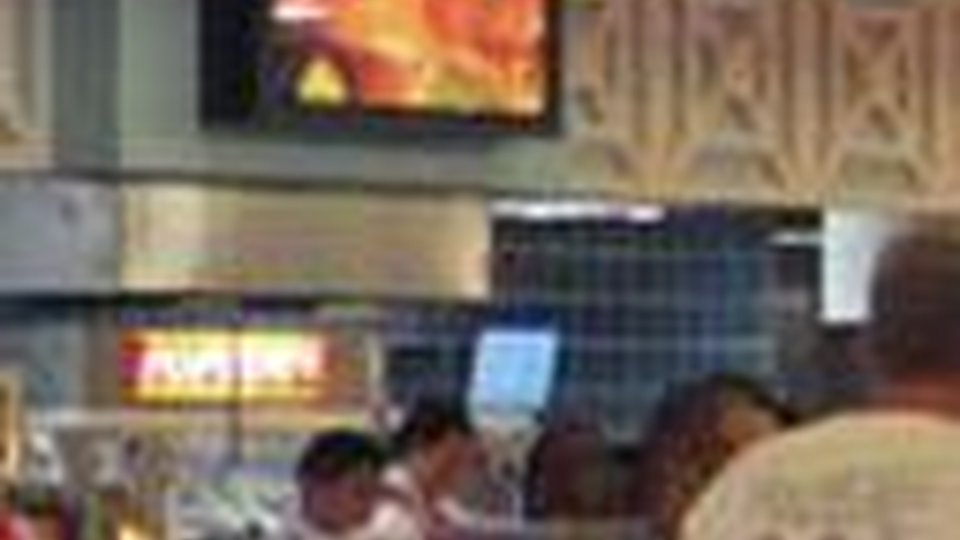Article
Digital signage at the movies
Screen technology enlivens concession menu boards and displays.

January 13, 2008
Digital signage technology is slowly making its way into theater chains nationwide —and in more ways than one. LCDs and plasma screens are popping up in all kinds of unexpected places: over concession stands, in box offices, hanging from lobby ceilings and along walls where those faded movie posters used to be.
A mouth-watering display
It's a weekly ritual for some: settling down for the latest thriller with a tub of buttered popcorn, a bag of M&Ms and a super-sized Pepsi. As many theater owners will reluctantly concede, the real profits in for theatres don't come from ticket sales. They stack up at the concession stand.
So when it comes to luring the hungry patrons to the hot dog broilers, theater owners are looking for advertising that captivates their attention. That means the static backlit menu boards are out and digital signage is in.
| |||||
| This story and all of our great free content is supported by: | |||||
 | Planar Systems Planar Systems delivers digital signage solutions that empower you to meet the full spectrum of your communication needs with flexible, centralized, up-to-the-minute adaptability. | ||||
Industry experts like Bryan Lesseraux, vice president of marketing for Holbrook, N.Y.-based IDS Menus Inc., a Scala certified partner, say consumers are much more likely to zero in on a moving picture.
"I think people can generally agree that we've seen a million static popcorn graphics," Lesseraux said. "If you do walk into a movie theater and you see butter being dripped onto popcorn, it definitely has a strong visual impact, and it's definitely going to attract attention. So yeah, the power of the image is definitely important."
Lesseraux says his company recently completed a large-scale installation of digital menu boards in the Los Angeles location of The Bridge Cinema de Lux, a high-end movie theater owned by National Amusements Inc. That deployment required the installation of 32 digital displays throughout the theater.
 |
Customers line up at Muvico concession stand and get their information from digital menu boards. (Photo courtesy Hammond Communications.) |
"With a [static] menuboard, you keep a single image up for a very long time," he said. "It can't be targeted based on day-parting or demographics. Now all of a sudden, with digital you have 1) a variety of messages, so you're sending more messages to more people at the simplest level, and 2) you start to target it based on day-parting." (Day-parting refers to the process of changing menu items on a digital display based on the time of day.)
Even more enticing to theater owners, digital menu boards can be programmed to automatically adjust the price of certain products to counter fluctuations in consumer demand and inventory levels. Craig Miller, vice president of interactive media for Lexington, Ky.-based Hammond Communications Inc., says his company was able to partner with Schult Industries and Radiant Technologies to make that type of intelligent and intuitive digital marketing a reality during a pilot program with Fort Lauderdale, Fla.-based Muvico Theaters.
"You can drive your inventory, if you will," Miller said. "You can use a POS system and integrate it. It's sophisticated enough today so that, without any human involvement, it can all be automated, so that if you've got 100 hot dogs left and it's 11 o'clock at night, you can set that animated hot dog combo to play and the price will be reduced."
Miller says the pilot took place in Muvico's Rosemont, Ill.-based facility, but the theater chain hopes to deploy similar systems in the rest of its theaters. Ultimately, the content of the menuboards will be remotely managed from Muvico's Florida headquarters.
A poster of a different color
Additionally, experts say digital signage will soon be replacing the monochrome LED displays that hang over the box office. Since these displays — which usually list movie titles along with showtimes — are text-based, experts like Lesseraux say it's a logical move following the replacement of static menu boards.
What's interesting is the possibility that you might soon see large digital displays where movie posters once were.
 |
A digital menu-board installation from Hammond Communications. |
Ryan Cahoy, the vice president of sales and marketing for Shawnee, Kan.-based Rise Vision Inc., says print posters are at a distinct disadvantage when compared with the new technology. They don't emit light, so they can be difficult to see in the evening. Their colors are lifeless. They're static, so there's no motion, and worst of all, they can become irrelevant at a moment's notice.
"Instead of every week, someone having to spend time putting up a new poster on the wall for the new movie that's coming out next week, it can all be done digitally and be easily updated across multiple theaters at the touch of a button," Cahoy said.
Best of all, Lesseraux says, the digital format dramatically reduces the cost associated with the manufacture and distribution of static posters.
"Let's say your poster cases are part of a networked digital-signage system," he said. "Obviously, there are up-front costs. But once you're tied in, there's no more printing of large-format graphics. So the whole process of creating the graphic and shipping it and all the people involved — that's all gone."
Editor's Note: Digital Signage Today is launching a guide called Digital Signage in Entertainmentin February. Clickhereto sign up to receive this publication.


